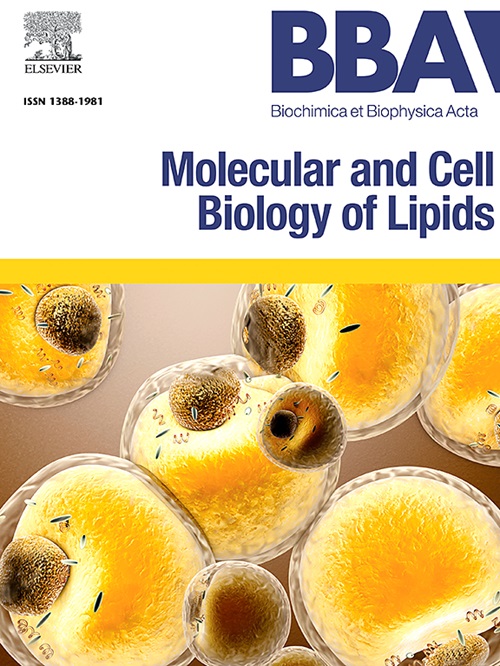Linarin alleviates high-fat diet-induced NAFLD via modulating the PI3K/Akt/mTOR pathway, autophagy, and gut microbiota
IF 3.3
2区 生物学
Q2 BIOCHEMISTRY & MOLECULAR BIOLOGY
Biochimica et biophysica acta. Molecular and cell biology of lipids
Pub Date : 2025-07-16
DOI:10.1016/j.bbalip.2025.159666
引用次数: 0
Abstract
Linarin (Lin) is a flavonoid compound widely found in traditional herbal medicines and is recognized for its diverse biological properties, including anti-inflammatory, analgesic, antioxidant, hepatoprotective, and anti-apoptotic effects. Non-alcoholic fatty liver disease (NAFLD) is closely associated with autophagy and inflammation processes. However, the interaction between Lin and NAFLD remains underexplored. This study aimed to investigate the protective effects of Lin against NAFLD and its underlying pharmacological mechanisms. In vitro, we established a NAFLD model using AML12 cells stimulated with oleic acid (OA) and palmitic acid (PA). In vivo, we induced a chronic model in mice by feeding them a high-fat diet (HFD). Lipid metabolism markers, Oil Red O staining, and H&E staining were used to assess intracellular lipid accumulation. Inflammatory and autophagic markers were also measured. The 16S rRNA analysis was performed to evaluate the changes in the gut microbiota composition after Lin intervention in mice. Both in vitro and in vivo experiments demonstrated that Lin reduces lipid accumulation, which is mediated through the enhancement of autophagy and the inhibition of the release of inflammatory factors. 16S rRNA analysis revealed that Lin alleviates gut dysbiosis by reducing Firmicutes and Bacteroidetes phyla while increasing the abundance of Akkermansia and Bifidobacterium genera. Mechanistically, Lin activates autophagy via the PI3K/Akt/mTOR pathway, thereby alleviating lipid accumulation and inflammation. These findings suggest that Lin can mitigate NAFLD by inhibiting the activation of the PI3K/Akt/mTOR pathway, highlighting its potential as a promising therapeutic approach for NAFLD.
Linarin通过调节PI3K/Akt/mTOR通路、自噬和肠道微生物群来缓解高脂肪饮食诱导的NAFLD。
Linarin (Lin)是一种广泛存在于传统草药中的类黄酮化合物,具有多种生物学特性,包括抗炎、镇痛、抗氧化、保护肝脏和抗细胞凋亡等作用。非酒精性脂肪性肝病(NAFLD)与自噬和炎症过程密切相关。然而,Lin与NAFLD之间的相互作用仍未得到充分探讨。本研究旨在探讨林对NAFLD的保护作用及其潜在的药理学机制。在体外,我们用油酸(OA)和棕榈酸(PA)刺激AML12细胞建立NAFLD模型。在体内,我们通过高脂饮食(HFD)诱导小鼠慢性模型。脂质代谢标志物、油红O染色和H&E染色用于评估细胞内脂质积累。还测量了炎症和自噬标志物。采用16S rRNA分析来评估Lin干预后小鼠肠道菌群组成的变化。体外和体内实验均表明,Lin通过增强自噬和抑制炎症因子的释放来减少脂质积累。16S rRNA分析显示,Lin通过减少厚壁菌门(Firmicutes)和拟杆菌门(Bacteroidetes),增加Akkermansia和双歧杆菌属(Bifidobacterium)的丰度,缓解肠道生态失调。在机制上,Lin通过PI3K/Akt/mTOR途径激活自噬,从而减轻脂质积累和炎症。这些发现表明Lin可以通过抑制PI3K/Akt/mTOR通路的激活来缓解NAFLD,突出了其作为NAFLD治疗方法的潜力。
本文章由计算机程序翻译,如有差异,请以英文原文为准。
求助全文
约1分钟内获得全文
求助全文
来源期刊
CiteScore
11.00
自引率
2.10%
发文量
109
审稿时长
53 days
期刊介绍:
BBA Molecular and Cell Biology of Lipids publishes papers on original research dealing with novel aspects of molecular genetics related to the lipidome, the biosynthesis of lipids, the role of lipids in cells and whole organisms, the regulation of lipid metabolism and function, and lipidomics in all organisms. Manuscripts should significantly advance the understanding of the molecular mechanisms underlying biological processes in which lipids are involved. Papers detailing novel methodology must report significant biochemical, molecular, or functional insight in the area of lipids.

 求助内容:
求助内容: 应助结果提醒方式:
应助结果提醒方式:


